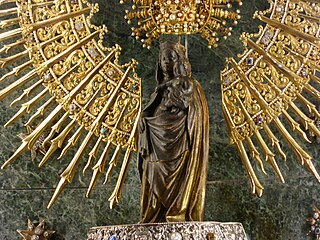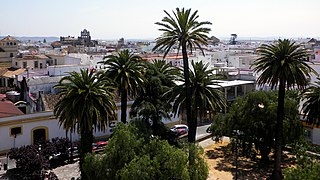
Salta is a province of Argentina, located in the northwest of the country. Neighboring provinces are from the east clockwise Formosa, Chaco, Santiago del Estero, Tucumán and Catamarca. It also surrounds Jujuy. To the north it borders Bolivia and Paraguay and to the west lies Chile.

Apurímac is a department in southern-central Peru. It is bordered on the east by the Department of Cusco, on the west by the Department of Ayacucho, and on the south by the Arequipa and Ayacucho departments. The department's name originates from the Quechua language and means "where the gods speak" in reference to the many mountains of the region that seem to be talking to each other.

Our Lady of the Pillar is the name given to the Blessed Virgin Mary in the context of the traditional belief that Mary, while living in Jerusalem, supernaturally appeared to the Apostle James the Greater in AD 40 while he was preaching in what is now Spain. Those who adhere to this belief consider this appearance to be the only recorded instance of Mary exhibiting the mystical phenomenon of bilocation. Among Catholics, it is also considered the first Marian apparition, and unique because it happened while Mary was still living on Earth.

El Puerto de Santa María, locally known as El Puerto and historically in English as Port Saint Mary, is a municipality of Spain located on the banks of the Guadalete River in the province of Cádiz, Andalusia. As of 2016, the city has a population of c. 88,184, of which some 50,000 live in the urban center, and the remainder in the surrounding areas.

Motril is a town and municipality of Spain belonging to the province of Granada, in the autonomous community of Andalusia.

The Tren a las Nubes is a tourist train service in Salta Province, Argentina. The service runs along the eastern part of the Salta–Antofagasta railway line of the Belgrano Railway that connects the Argentine Northwest with the border in the Andes mountain range, over 4,220 metres (13,850 ft) above mean sea level, the fifth highest railway in the world. Originally built for economic and social reasons, it is now primarily of interest to tourists as a heritage railway, though cheaper tickets are also available for locals to use the train as transport.

The Virgin of the Valley is a Roman Catholic title of the Blessed Virgin Mary venerated in Margarita Island, Venezuela and Catamarca, Argentina.

Our Lady of Solitude of Porta Vaga also known as the Virgin of a Thousand Miracles is a Roman Catholic Marian title of Mary, mother of Jesus, based on the Marian apparitions reported in 1667 by a Spanish soldier during a night storm when he watched over the gates of Porta Vaga, later on the next day the icon was discovered in the seashore of Cañacao bay. The Virgin of Soledad is a venerated Marian icon associated to the Our Lady of Solitude. The province of Cavite and the city of Cavite consider her as its patroness.

The Virgin of Candelaria or Our Lady of Candle (Tagalog: Mahal na Birhen ng Candelaria, popularly called La Morenita, celebrates the Virgin Mary on the island of Tenerife, one of the Canary Islands. The center of worship is located in the city of Candelaria in Tenerife. She is depicted as a Black Madonna. The "Royal Basilica Marian Shrine of Our Lady of Candelaria" is considered the main church dedicated to the Virgin Mary in the Canary Islands and she is the patroness saint of the Canary Islands. Her feast is celebrated on February 2 and August 15, the patronal feast of the Canary Islands.

"Bajada" is the shortened version of the Fiestas de la Bajada which is a festival which takes place in several places in the Canary Islands. Bajada is Spanish for "bringing down", and means the bringing of a patron saint's statue from its normal place in a chapel to be celebrated by the people.
The Hermosa Festival, also known as Zamboanga La Hermosa Festival, popularly known as Fiesta Pilar, is a month-long festival held annually in Zamboanga City, Philippines. It is one of the oldest festivals in the country and the most awaited event in the region.

Our Lady of Luján is a celebrated 16th-century statue of the Virgin Mary, mother of Jesus Christ. The image, also known as the Virgin of Luján, is on display in the Basilica of Luján in Argentina. The feast day of Our Lady of Luján is May 8.

Our Lady of Andacollo, also known as the Virgin of Andacollo, is a celebrated Catholic statue of the Virgin Mary located in the town of Andacollo, in the Coquimbo Region in the north of Chile. The carving is the centre of the annual Fiesta Grande de la Virgen that draws thousands of pilgrims from around the world in December.
The 1844 Salta earthquake took place in the Province of Salta, in the Republic of Argentina, on 18 October at 23:00 UTC. It had an estimated magnitude of 6.5 . The earthquake had an estimated hypocentral depth of 30 km.
The 1871 Orán earthquake that took place in the Province of Salta, in the Republic of Argentina, on Tuesday, 9 October 1871 at 02:15. It had an estimated magnitude of 6.4 . The earthquake was located at a depth of 30 kilometres (19 mi).

The Basilica of Nuestra Señora del Prado is a Roman Catholic basilica in Talavera de la Reina, Spain.
The Salta Identity Party is a provincial political party in the Salta Province of Argentina. It was founded by Gustavo Sáenz ahead of the 2015 general election; Sáenz has been governor of Salta since 2019.

Our Lady of Altagracia or the Virgin of Altagracia, in Catholic Marian devotion, is a title of Mary by which she is honored as the “protective and spiritual mother of the Dominican people.” The title also is used for a particular image of Mary with the baby Jesus in a manger. Her patronal feast day is January 21, a holiday/non-working day in the Dominican Republic on which many faithful devotees of the Virgin come from all over the Dominican territory to the Basilica-Cathedral of Our lady of Altagracia, in the province of La Altagracia. Devotion to her is also prominent in areas outside of the Dominican Republic where Dominican influence flourishes, including New York City, where her feast marks the beginning of Dominican Heritage Month.
Marcos Ginocchio is an Argentine model, lawyer and TV personality. He won the 10th season of the Argentine reality television series Gran Hermano.

















